Celebrating
|
Slow Pitch Jigging
|
| New system features refined gear and specialized jigs. |
| by George Poveromo |
| RETURN TO HOW TO'S MAIN PAGE - CLICK HERE |
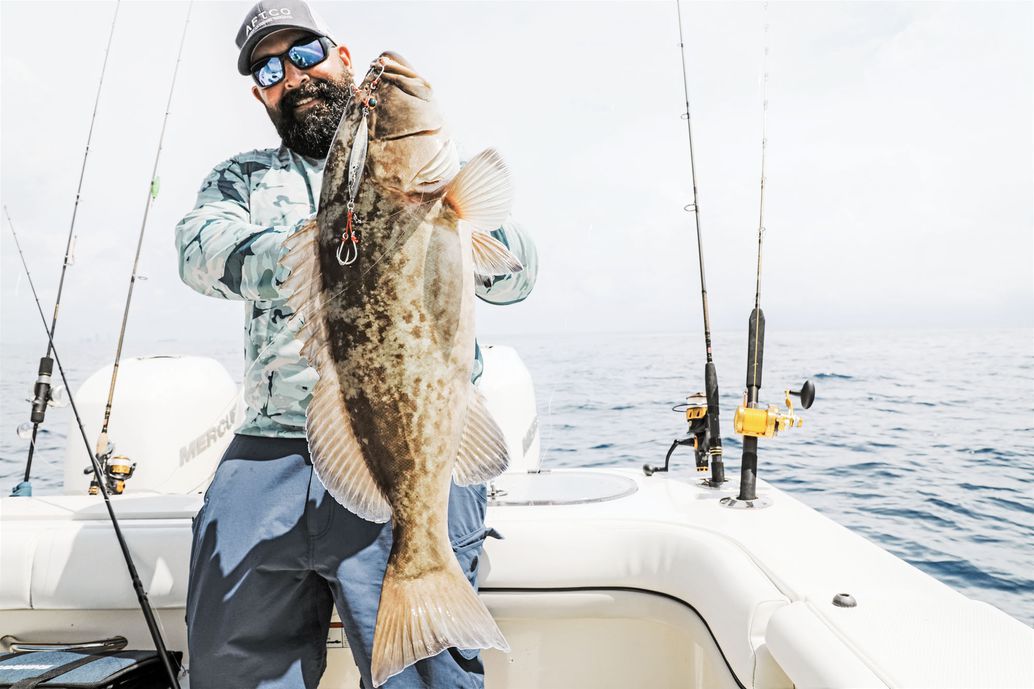 Innovative tackle and technique along with specialized lures give anglers a fresh start on tempting wizened grouper. George Poveromo |
| A calm ocean off Miami Beach presented an ideal opportunity to jig over a series of deep wrecks and bottom structure, such as the rubble patch in 430 feet of water where Benny Ortiz hooked up. His long, whippy rod—bent nearly double—appeared more art deco-like than a serious jigging outfit. Yet the magic unfurled as Ortiz fought the fish off the reel (read: no rod pumps) until he boated a beauty of a snowy grouper. Back With a Vengeance Ortiz had joined Harry Vernon III, Carl Grassi and me aboard Marc VI, to showcase the finer points of slow-pitch jigging (SPJ). A local pioneer of the tactic, Ortiz has taken 70 species out to depths flirting with 1,000 feet. You'd think catching bottomfish with irons in heavily pressured waters would be futile versus live-baiting—not for Ortiz. He pressed on, adding a gag grouper and a blackfin tuna to his tally during our half-day outing. Slow-pitch jigging came to the U.S. over a decade ago from Japan, and was marketed here with specialized rods, reels, lines and irons. Within the last two years, interest in the method has ramped up in a second wave, if you will. Perhaps it’s the willingness of old-school anglers to divert a bit from traditional techniques, the posting of impressive SPJ catches on social media, the unusual tackle, or all of the above. Regardless, the popularity builds as anglers employing the gear continue to post impressive catches from bays, sounds, and out to the canyons. |
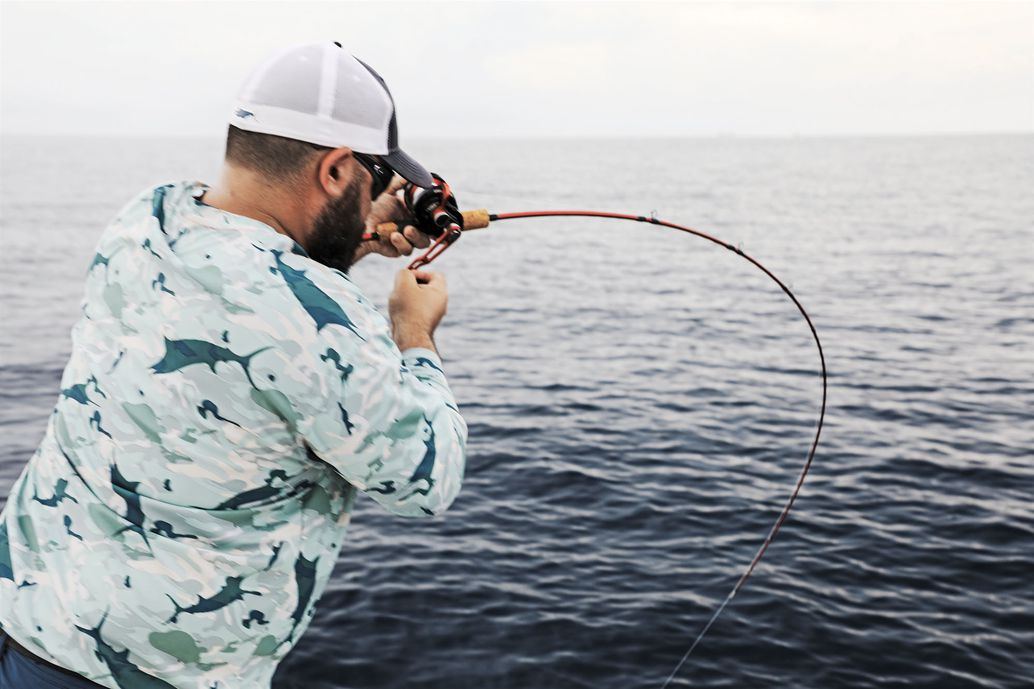 An angler fights a fish from the reel, with the soft rod as a shock absorber. George Poveromo |
| Why Effective? Ortiz explains that SPJ tackle works as a system. Compared to traditional deep and flutter jigging, where the injured-bait illusion takes place in a narrow section of the water column, SPJ unfurls the action over a broader swath. Long, whippy rods lift and kick the jigs laterally, like an injured fish struggling to swim upward and away from the bottom prior to wobbling back during the free fall. "The action is typical of how an injured fish reacts down there," Ortiz says. "The illusion provokes fish to strike instinctively, not necessarily out of hunger. That's why the tactic had become so popular in Japan, where there's heavy fishing pressure; commercial fishermen are always challenged to find better ways to entice fish into striking." This concept resonates over artificial and natural reefs and bottom structure off South Florida, where the highest concentrations of bottom and offshore anglers in the state translates into major fishing pressure with live baits and specialized rigs. Yet these irons routinely outproduce live baits. |
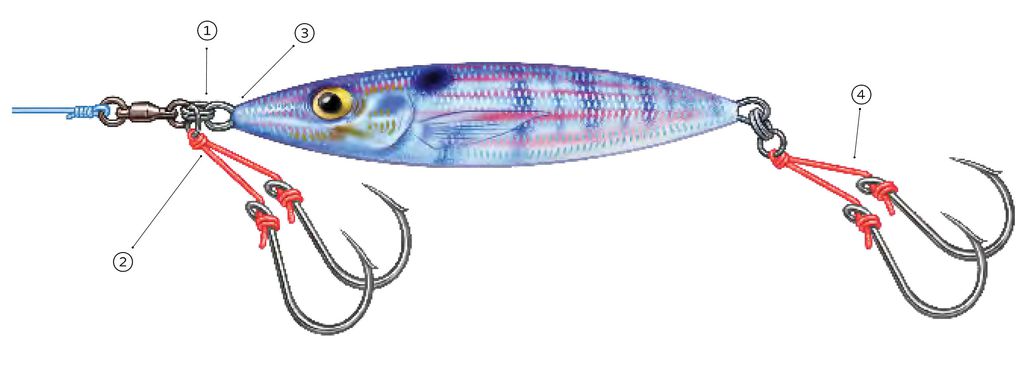 Tie a barrel swivel to the end of the leader and attach a split ring, 1. This split ring then allows attachment of a rigged pair of assist hooks, 2, as well as the jig, 3. On larger jigs, add a second pair of rigged assist hooks at the tail, on a split ring, 4. Make sure the two pairs of hooks cannot tangle. On shorter jigs, stick with a single pair of hooks at the top. Steve Sanford |
| Iron It Out Ortiz uses lures by NLO, Seafloor Control and Sea Falcon, although numerous brands work. He selects the lightest iron that holds bottom, with a pair of assist hooks at the top and the bottom. He prefers hooks with external barbs to reduce tangles and aid hookups. To facilitate the quick change of irons, he adds a barrel swivel to his leader with a split ring at the outboard end. The solid ring eye on a pair of assist hooks then slips onto the split ring. The jig hangs from the same split ring. The jigs carry a pair of hooks at the bottom, for a total of four. In shallow water, Ortiz matches the jig color to the prominent baitfish. Out deep, he prefers colors that include glow stripes or accents. He also carries a portable UV light to charge up a glow iron. |
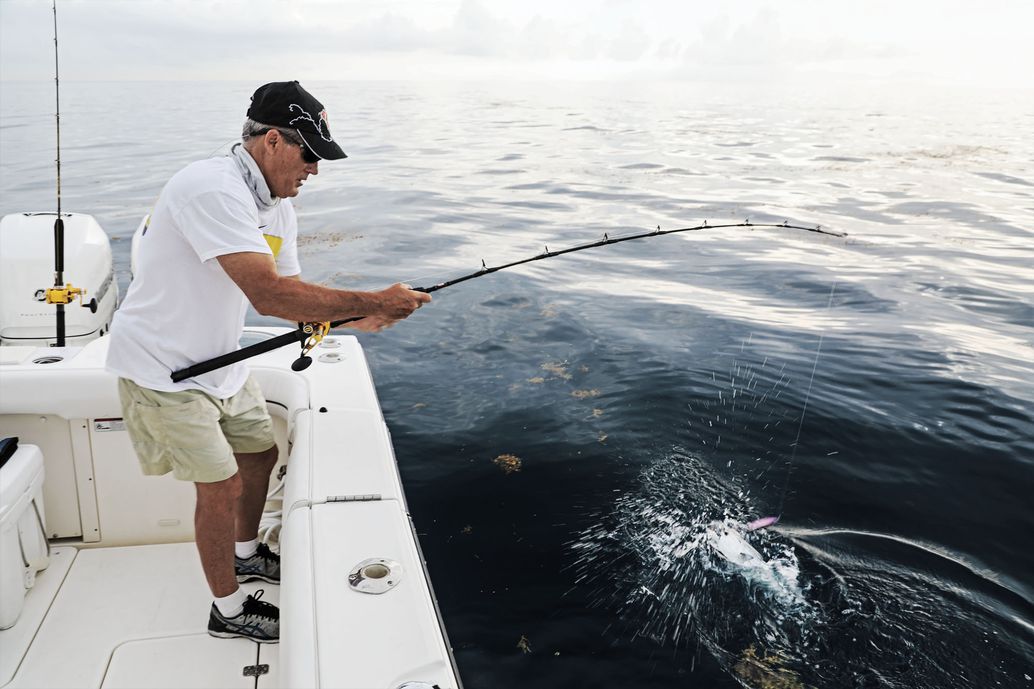 An angler prepares to leader a successful slow-pitch catch. George Poveromo |
| Rod Logic Ortiz carries several SPJ rods from 6 to 7 feet. "High-quality slow-pitch jigging rods are thin and have a high carbon content," Ortiz says. "They're extremely sensitive and elastic, which gives the rod its most important characteristic: recoil." The higher quality the rod, the better recoil it will have, and the better it works jigs in deep water. You don’t want a fast-action rod that springs back quickly, but rather a rod with an even, slow recovery. Slow-pitch rods are generally equipped with micro guides, which are shockingly small at first glance. The reason: sensitivity. The closer your line is to the blank, the more sensitivity you have to the slightest strike, even hundreds of feet below. This requires you learn to tie slim line-to-line connections, such as an FG or PR knot. |
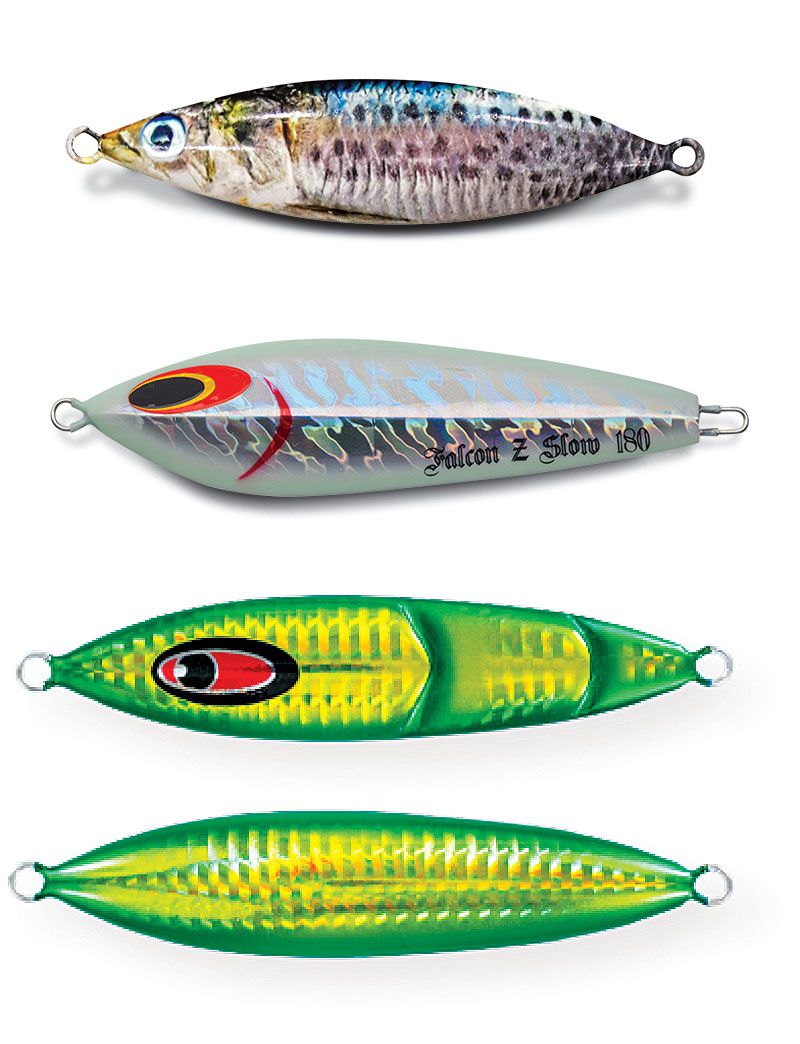 Slow-pitch, or "fall", jigs, vary in color schemes and body configuratons for a tailored presentation. Top to bottom: NLO Scoop: Realistic patterns, most effective in shallower water, mimic struggling baitfish. Sea Falcon Z Slow Jig: An exaggerated body profile creates additional planes that amplify action on the retrieve. SeaFloor Control Cranky Jig: Stepped body configuration creates an enticing, irregular fall; bright or glow colors show well at depth. George Poveromo |
| Reels, Lines and Leaders Small conventional reels with high retrieve ratios rule, and durable gears and drags are essential because fish are fought off the reel. "A retrieve of 36 to 40 inches per revolution is preferred," Ortiz says. "That's where the pitch comes in; a pitch is another term for one full turn of the reel handle. The fast retrieve quickly removes slack from the line, complementing the radical action provided by the jig design and the rod." The lighter the braid, the easier a jig sinks. Ortiz spools with 30-pound braid for most fishing. He uses an FG or PR knot to join a 12- to 15-foot, 50-pound fluoro leader, which easily passes through the rod guides. |
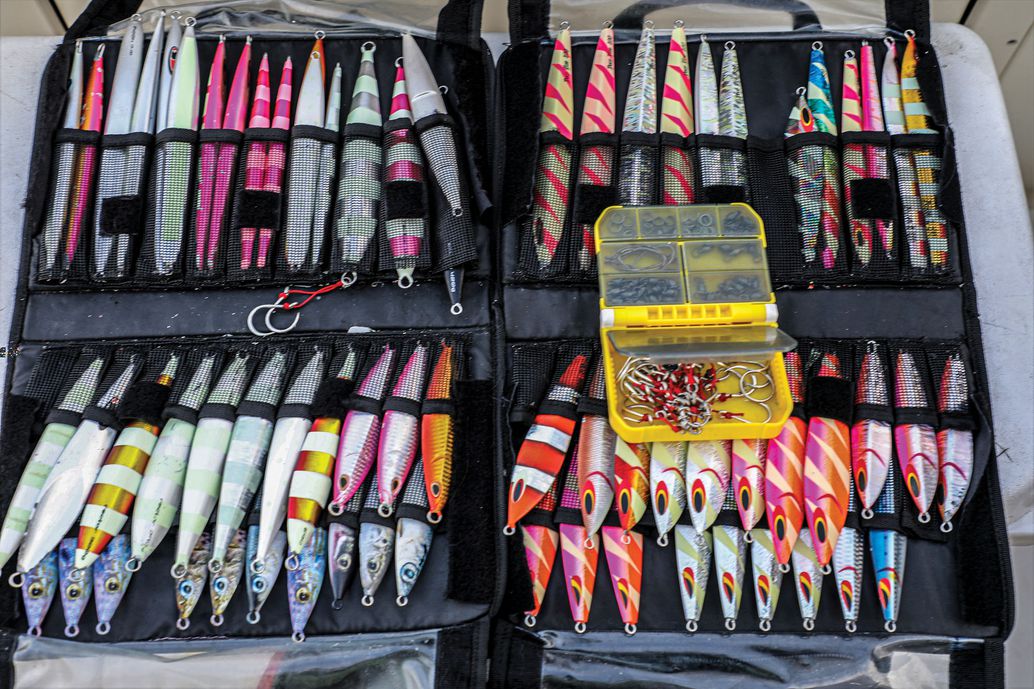 A well-equipped kit includes jigs of varying weights, colors and body profiles to meet any situation. George Poveromo |
| Details Yield Results Concentrating over wrecks and structure from 130 to 500 feet, Vernon alternated between flutter jigging and SPJ with Ortiz's tackle. Grassi played with slow-pitch jigging, but mostly fished live pilchards and goggle-eyes on the bottom. When the smoke cleared, Ortiz had the most hookups, with the largest of two snowy grouper (Grassi caught a small one on a pilchard), a big gag grouper and a blackfin tuna; he also pulled the hooks on two sizable bottomfish. Vernon caught a bonito. Ortiz is smooth, consistent and efficient on the rod. “Once the jig reaches bottom, crank the reel handle as you initiate the upward rod sweep,” he says. “Be mindful to push the rod outward during the lift, to help direct the jig. Then let the jig flutter down. Do not reel as the jig falls. Then repeat the motion a couple of times, reacquire bottom, and repeat. It’s a rhythm thing. Once you get the hang of it, it’s like riding a bicycle; it becomes simple.” |
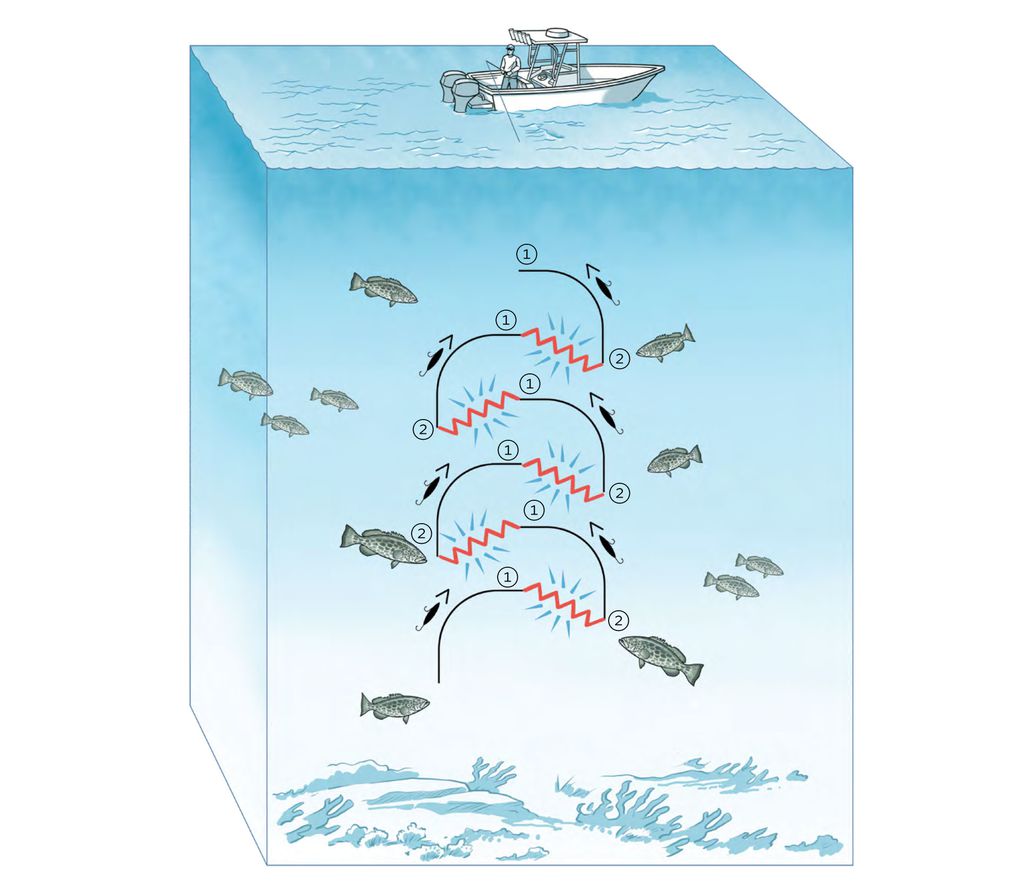 Slow-pitch jigging demands a disciplined retrieve. The body profile of the jig dictates its action on the fall and the retrieve, which is controlled by the angler. Fall jigs are designed to move laterally across the water column on the retrieve, 1, then tumble or flutter on the drop, 2. Developing a rhythm to coordinate those two actions lies at the heart of the slow-pitch technique. Steve Sanford |
| Ortiz keeps the rod butt under his forearm for leverage and comfort. On the strike, he winds until the rod tip dips toward the surface, then, keeping the rod aimed at the fish, he begins fighting it off the reel. The objective is to stay tight to the fish and fight smoothly. Compared to traditional deep and flutter jigging, slow-pitch jigging requires discipline. With traditional jigging rods, you merely impart action and fight a fish while either palming a reel (for small fish) or from a rod belt (for large fish). Then you pump the rod during the fight. Prior to hooking up, the jigging actions are pretty much straight up and down. It’s hard to acquire the different rhythm and subtleties because they differ from the norm, but practice makes perfect. Once you get beyond the cost of a quality SPJ outfit (around $1,000 for a top-tier setup), the next hurdle to overcome is the initial awkwardness of the tactic itself. But, as Ortiz will tell you, it sure is hell on fish. And that alone is worth adding this jigging strategy to your bottomfishing arsenal. |
| RETURN TO HOW TO'S MAIN PAGE - CLICK HERE |

